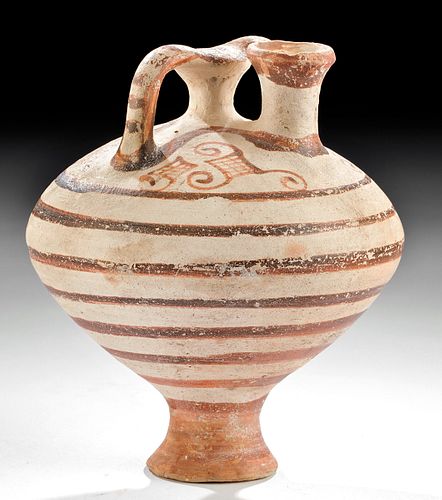Mycenaean Bi-chrome Piriform Stirrup Vessel
Lot 17b
About Seller
Artemis Fine Arts
686 S Taylor Ave, Ste 106
Louisville, CO 80027
United States
Selling antiquities, ancient and ethnographic art online since 1993, Artemis Gallery specializes in Classical Antiquities (Egyptian, Greek, Roman, Near Eastern), Asian, Pre-Columbian, African / Tribal / Oceanographic art. Our extensive inventory includes pottery, stone, metal, wood, glass and textil...Read more
Categories
Estimate:
$2,000 - $3,000
Absentee vs Live bid
Two ways to bid:
- Leave a max absentee bid and the platform will bid on your behalf up to your maximum bid during the live auction.
- Bid live during the auction and your bids will be submitted real-time to the auctioneer.
Bid Increments
| Price | Bid Increment |
|---|---|
| $0 | $25 |
| $300 | $50 |
| $1,000 | $100 |
| $2,000 | $250 |
| $5,000 | $500 |
| $10,000 | $1,000 |
| $20,000 | $2,500 |
| $50,000 | $5,000 |
| $100,000 | $10,000 |
| $200,000 | $20,000 |
About Auction
By Artemis Fine Arts
Feb 13, 2020
Set Reminder
2020-02-13 10:00:00
2020-02-13 10:00:00
America/New_York
Bidsquare
Bidsquare : Exceptional Antiquities, Asian, Ethnographic
https://www.bidsquare.com/auctions/artemis-gallery/exceptional-antiquities-asian-ethnographic-4848
An important one-day auction featuring museum-worthy examples of Egyptian, Greek, Roman, Etruscan, Near Eastern, Far East / Asian, Pre-Columbian, African / Tribal, Oceanic, Native American, Spanish Colonial, Russian, Fossils, Ancient Jewelry, Fine Art, so much more! Artemis Fine Arts info@artemisgallery.com
An important one-day auction featuring museum-worthy examples of Egyptian, Greek, Roman, Etruscan, Near Eastern, Far East / Asian, Pre-Columbian, African / Tribal, Oceanic, Native American, Spanish Colonial, Russian, Fossils, Ancient Jewelry, Fine Art, so much more! Artemis Fine Arts info@artemisgallery.com
- Lot Description
Ancient Greece, Mycenaean Period, Late Helladic IIIB to IIIA, ca. 1300 to 1100 BCE. An attractive wheel-thrown pottery vessel exhibiting a broad piriform body, a gently rounded shoulder with dense red-slipped decorations, a pair of stirrup-shaped handles that join at the top of a false central spout, and a functional, off-set spout on one side of the shoulder. The handle and spout are decorated with red-orange stripes and solid rings, with repeating rings covering the body, and the shoulder boasts abstract zoomorphic illustrations with scorpion-like bodies and curling tails. A handsome example of utilitarian pottery from a time when Mycenae was at its peak of influence in the Mediterranean. Size: 3.9" W x 4.5" H (9.9 cm x 11.4 cm)
This period is so named for the palace at Mycenae, famed in Homeric legend as the opulent seat of King Agamemnon. Excavations at the palace at Mycenae revealed an elite and long-lasting society with a great deal of wealth. This extended to the workshops of artisans who produced pottery like this vessel both for use in Greece and throughout the Mediterranean world; shiploads of similar jars went out as far as the Levant and Spain, carrying oil, wine, and other commodities.
For two stylistically similar examples of stirrup jars from the Late Helladic III Period, please see The Metropolitan Museum of Art, accession numbers 74.51.745 and 74.51.736.
Provenance: private East Coast, USA collection; ex-William Froelich collection, New York, USA, acquired in the 1970s
All items legal to buy/sell under U.S. Statute covering cultural patrimony Code 2600, CHAPTER 14, and are guaranteed to be as described or your money back.
A Certificate of Authenticity will accompany all winning bids.
We ship worldwide and handle all shipping in-house for your convenience.
#152868Repairs to areas of spout, body, and foot, with minor restoration in those areas, and resurfacing and overpainting along new material and break lines. Minor abrasions and nicks to handle, spout, body, and foot, and chipping and fading to areas of original pigment. Light earthen deposits and nice traces of original pigment with great craquelure throughout.Condition
- Shipping Info
-
All shipping is handled in-house for your convenience. Your invoice from Artemis Gallery will include shipping calculation instructions. If in doubt, please inquire BEFORE bidding for estimated shipping costs for individual items.
-
- Buyer's Premium



 EUR
EUR CAD
CAD AUD
AUD GBP
GBP MXN
MXN HKD
HKD CNY
CNY MYR
MYR SEK
SEK SGD
SGD CHF
CHF THB
THB
















